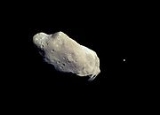
Karin Cluster
Encyclopedia
The Karin asteroid family
or Karin cluster is a sub-family of the Koronis family
. It consists of at least 90 main-belt asteroid
s. What makes them special is that scientists have used the orbits of 13 members to calculate backwards until they were all found to share the same orbit — that of the parent body from which they all originated.
 The family is named for its largest member, 832 Karin
The family is named for its largest member, 832 Karin
, which has a diameter of about 19 km (11.8 mi). It represents about 15–20% of the mass of the original body which had an estimated diameter of 33 km (20.5 mi). (832) Karin is an S-type asteroid. (4507) 1990FV was originally thought to be a member of the family but was identified in 2004 as an interloper. The other members have diameters in the 1–7 km range (0.6–4.3 miles).
The family is believed to have been created 5.8 ± 0.2 million years ago, making it the most recent known asteroid collision. Because the surfaces of the family members are relatively pristine, spectroscopic analysis can tell scientists much about their composition and could shed new light on the question of how closely asteroids and meteorites are related. The fact that we know when their surfaces were formed will also be useful in determining the rate of crater formation in asteroids. It is estimated that in about 100 million years the family will have dispersed to a degree where it cannot be separated from the background population of asteroids.
The family may also be the source of one of the interplanetary dust bands discovered by the IRAS
satellite and may also have generated meteorites which would have compositions consistent with S-type asteroids and cosmic ray
exposure ages of approximately 5.8 million years.
A study of the Karin family has for the first time detected the Yarkovsky effect
in main belt asteroids.
Asteroid family
An asteroid family is a population of asteroids that share similar proper orbital elements, such as semimajor axis, eccentricity, and orbital inclination. The members of the families are thought to be fragments of past asteroid collisions...
or Karin cluster is a sub-family of the Koronis family
Koronis family
]The Koronis family is a family of asteroids in the main belt between Mars and Jupiter. They are thought to have been formed at least two billion years ago in a catastrophic collision between two larger bodies. The largest known is about in diameter. The Koronis family travels in a cluster along...
. It consists of at least 90 main-belt asteroid
Asteroid
Asteroids are a class of small Solar System bodies in orbit around the Sun. They have also been called planetoids, especially the larger ones...
s. What makes them special is that scientists have used the orbits of 13 members to calculate backwards until they were all found to share the same orbit — that of the parent body from which they all originated.

832 Karin
832 Karin is a minor planet orbiting the Sun. It is named after Queen Karin Månsdotter It is the largest member of the Karin Cluster, which is named after it. Found in 2002, the Karin cluster is notable for being very young...
, which has a diameter of about 19 km (11.8 mi). It represents about 15–20% of the mass of the original body which had an estimated diameter of 33 km (20.5 mi). (832) Karin is an S-type asteroid. (4507) 1990FV was originally thought to be a member of the family but was identified in 2004 as an interloper. The other members have diameters in the 1–7 km range (0.6–4.3 miles).
The family is believed to have been created 5.8 ± 0.2 million years ago, making it the most recent known asteroid collision. Because the surfaces of the family members are relatively pristine, spectroscopic analysis can tell scientists much about their composition and could shed new light on the question of how closely asteroids and meteorites are related. The fact that we know when their surfaces were formed will also be useful in determining the rate of crater formation in asteroids. It is estimated that in about 100 million years the family will have dispersed to a degree where it cannot be separated from the background population of asteroids.
The family may also be the source of one of the interplanetary dust bands discovered by the IRAS
IRAS
The Infrared Astronomical Satellite was the first-ever space-based observatory to perform a survey of the entire sky at infrared wavelengths....
satellite and may also have generated meteorites which would have compositions consistent with S-type asteroids and cosmic ray
Cosmic ray
Cosmic rays are energetic charged subatomic particles, originating from outer space. They may produce secondary particles that penetrate the Earth's atmosphere and surface. The term ray is historical as cosmic rays were thought to be electromagnetic radiation...
exposure ages of approximately 5.8 million years.
A study of the Karin family has for the first time detected the Yarkovsky effect
Yarkovsky effect
The Yarkovsky effect is a force acting on a rotating body in space caused by the anisotropic emission of thermal photons, which carry momentum...
in main belt asteroids.

